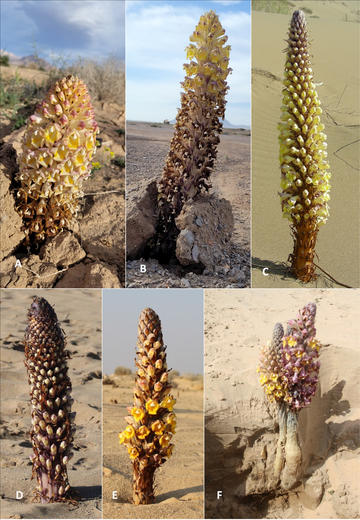
Cistanche species putatively found in Iraq and adjacent territories A, B: C. tubulosa (photographed in Iran) C, D: C. flava (photographed in Kazakhstan) E, F: C. tubulosa (photographed in Iraq)
Oxford Botanic Garden and Arboretum Deputy Director Dr Chris Thorogood has recently co-authored an account of the genus Cistanche in Iraq, published in PhytoKeys.
Dr Thorogood and co-authors Dr Majed Aldughayman, Professor Julie Hawkins and Professor Abdulridha Al-Mayah examined surviving specimens, images of living material, and taxonomic literature to provide as full an account as possible of the genus in the region where there has been considerable confusion in the past. This work will be used to inform the Flora of Iraq – and other treatments for the genus in the Middle East more broadly.
Iraq is home to an estimated 3,300 species of plant owing to its varied climate and topography. Until the mid-20th century, no comprehensive accounts existed for the region; the first national checklist was published in the 1950s. In 1964, The Flora of Lowland Iraq was published and included a treatment for the Orobanchaceae, the family to which the genus Cistanche belongs.
The Flora of Iraq project, initiated as a collaboration between the Royal Botanic Gardens, Kew and the Ministry of Agriculture, Baghdad, began the following year. Several volumes were published, but political instability in the region led to its suspension in the 1980s, leaving volumes 5, 6, and 7 unfinished. In 2013 the project resumed, and volumes 6 and 7, covering approximately 900 species, are currently in progress. A new treatment for the Orobanchaceae has been written by Dr Thorogood and colleagues, and is currently in press.
Cistanche species are difficult to identify with certainty. As a holoparasitic plant, Cistanche lacks functional leaves and roots. Specimens in herbaria are often in poor condition, and specimens can be difficult to distinguish in the field.
The genus Cistanche has a long history of use as a food and in herbal medicine in semi-arid and arid regions, and many species of the genus are rare or of conservation concern. The recent neotypification of C. tubulosa has helped to resolve taxonomic uncertainties, but further phylogenetic work is required to fully understand species limits within the genus.
The authors considered three taxa putatively found in the region: Cistanche salsa, C. flava and C. tubulosa. An additional five taxa were discounted as their distributions and morphology suggested they were unlikely to occur in the region, and two more taxa were excluded as they were considered to be exceptionally unlikely to occur in the Middle East. In some cases, taxa were not sufficiently described as to justify positive identification. Following this review, the authors determined that only one species could be identified with certainty: C. tubulosa, known as Zib Al-Zumal, Thenun Al-Jinn and Halook.
It is hoped that this taxonomic account for Cistanche in the region will support further re-evaluation of the genus, and this work underscores the importance of using multiple stable characters to better understand species limits.